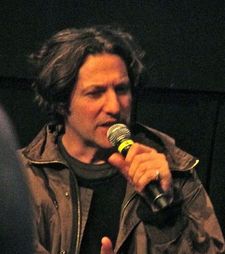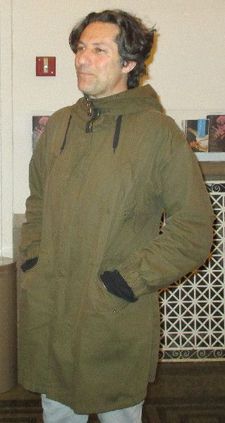![Under The Skin producer Jim Wilson with Jonathan Glazer BAMcinématek: "I was sent [Michel Faber’s] book 10 or 11 years ago."](/images/newsite/Jim_Wilson_Jonathan_Glazer_4X_1_600.jpg) |
| Under The Skin producer Jim Wilson with Jonathan Glazer BAMcinématek: "I was sent [Michel Faber’s] book 10 or 11 years ago." Photo: Anne-Katrin Titze |
A preview screening of Jonathan Glazer's unearthly Under The Skin, starring an otherworldly Scarlett Johansson, at BAMcinématek in Brooklyn was followed by a Q&A with the director and co-producer Jim Wilson, moderated by Dave Fear. After the screening, I spoke with Glazer about insects, seal maidens, costume design and how Jacques Lacan’s mirror phase is always somewhat present. Wilson, during the discussion expressed optimism for the state of film due to the work of Lars von Trier, Michael Haneke, Wong Kar-wai and Lynne Ramsay.
Under The Skin is told almost exclusively from the perspective of an alien, played by Johansson who slips into our world to harvest from mankind. Her circumstances, the why and wherefore, remain a mystery, while she plucks unsuspecting collaborators from the streets of Glasgow. The men were mostly filmed with hidden cameras, and asked for their permission to be used in the film later.
Anne-Katrin Titze: A lot of thought must have gone into the choice of costume [credited to Steven Noble]. She [the nameless character played by Johansson] is wearing the same clothes throughout the film. I am curious about the fake fur jacket in particular. Her change begins when she sheds that skin. Were you thinking of legends of seal maidens, of non-human creatures dressed in fur for your alien?
 |
| Jonathan Glazer on costume: "I think the whole look of Scarlett Johansson was always supposed to be a little bit off." Photo: Anne-Katrin Titze |
Jonathan Glazer: Was I thinking of seal maidens? Who doesn’t? Not specifically but certainly you can refer to the fur as another skin. I think the whole look of Scarlett Johansson was always supposed to be a little bit off. It was supposed to be a construction of sorts. I must credit a costume designer we spoke to at some point, who didn’t end up being our costume designer. He was talking about the idea of her costume being something which might be equivalent to somebody who recently immigrated - so somebody who might not understand necessarily the nuance of clothes in the same way, coming to a new culture. There’s something about that that we thought was very interesting.
AKT: I noticed the placement of two insects. There is an ant at the beginning and a fly near the end. Is there a relation between those two?
JG: They are part of nature.
AKT: When the alien discovers her image in the mirror, her transformation seems to occur. Were you thinking about Lacan? Is she entering the symbolic order?
JG: No, not specifically. But there's always something Lacanian about placing a mirror.
Here are some of the highlights from Fear's post screening discussion with Glazer and producer Jim Wilson.
Jim Wilson: I was sent the book [Michel Faber’s Under The Skin, 2000] 10 or 11 years ago.
Jonathan Glazer: We wrote the script in many versions and came full circle back to the origin. It was to be from her perspective. Early on we had a lot of conversations because I thought the film was un-cast-able, really. The very fact that the character was to be an alien it seemed absurd to cast someone familiar from films and magazines. And then we came to this idea of disguise and hidden cameras. The methodology makes sense with the story and Scarlett was a natural choice and became ideal.
She lures her victims into a shiny black pool of ominous thick liquid - eating and sleeping have a decidedly different standing in her realm. Johansson pulls it all together.
JG: There was no conversation about aliens whatsoever. It goes nowhere obviously that conversation. It was trying to find an equivalent that she could use in her head – appetite became a key word.
 |
| Jonathan Glazer at a preview of Under The Skin on a wintry spring evening: "Was I thinking of seal maidens? Who doesn’t?" Photo: Anne-Katrin Titze |
Reality and the radical other, nature and city life, rituals and surprise - questions of humanity slide into the oily abyss. While US viewers adjust to the Scottish accents and the faces in the crowd of the everyday, something curious can happen. The walking and talking, smoking and shopping looked at with alien eyes become the strange and unknown.
JG: I work with a really very close bunch of collaborators I have worked with for years. We start to talk about the project long before it actually happens. It’s a very collaborative situation. In terms of how it was going to look, what we needed to do was to build cameras. We needed cameras small enough to hide but in a quality that was good enough to project … The quality came from the need to shoot like that. Things needed to be unadorned. It was very much about showing reality, showing things how they are and not interfering with them.
Jim Wilson talked about shifts in the importance of cinema.
JW: We were having a conversation today about how maybe the generation that we're part of, grew up with cinema as a medium that had a certain primacy, like music. A certain kind of idea of music and cinema. We're in our mid- to late forties and the generation that came after us, a whole generation that hasn't grown up with cinema as being this iconic medium. Makes you worry that generations aren't growing up with that, so therefore, what feeds that hunger and desire? We grew up watching films of European art cinema and American Sixties, Seventies cinema that was influenced by European art movements from the Fifties and Sixties… Again, one could be pessimistic but I spent a lot of time going to film festivals over recent years. There are incredible filmmakers, like Lars von Trier, Michael Haneke, Wong Kar-wai, Lynne Ramsay.
The cast possesses a nature unique to Under The Skin.
JG: A lot of people were not aware they were in the film until the end, and then there were other people we cast beforehand. Some were non-actors, others had acted in a couple of things. Paul Brannigan who is the character she meets at the nightclub, he was in a Ken Loach film. And then the unbelievable cast we found. The idea of the film was to bring the film to the cast, rather than bring the cast to the film. When we settled on our locations, we would look at that location for the cast that needed to be in that scene. The woodsman, for example, was someone who lived at the edge of that forest.
Nature here can be sublime in a moment of Caspar David Friedrich serenity and filled with terror in the most haunting scene in the movie in which a little child at night alone on a rocky beach cries into the wind at the brink of the stormy sea.
JG: The film needed to stand apart because it is told from an alien point of view. It needed to be in itself a kind of an alien experience… Obviously what that scene [on the beach] is all about is her impassive witnessing of this event that to her is like watching mammals. We see the awful tragedy in it and she just sees the movement of these animals she doesn't really care about… The man with the disfigured face is an indicator. She comes across someone at the margins of society and there's a similarity and there's a recognition in that for her. It's also a mirror in a sense. He is Beauty and she is the Beast. There's tenderness in there, there's a lot of aspects to that scene. You could read it literally as if she's a human being or that she sees nothing in that skin that she has any judgement over. She is not interested in the way he looks. The skin is like a plastic bag holding the content of what she is interested in.
Under The Skin is currently showing in the US and will be out soon on DVD in the UK.





















